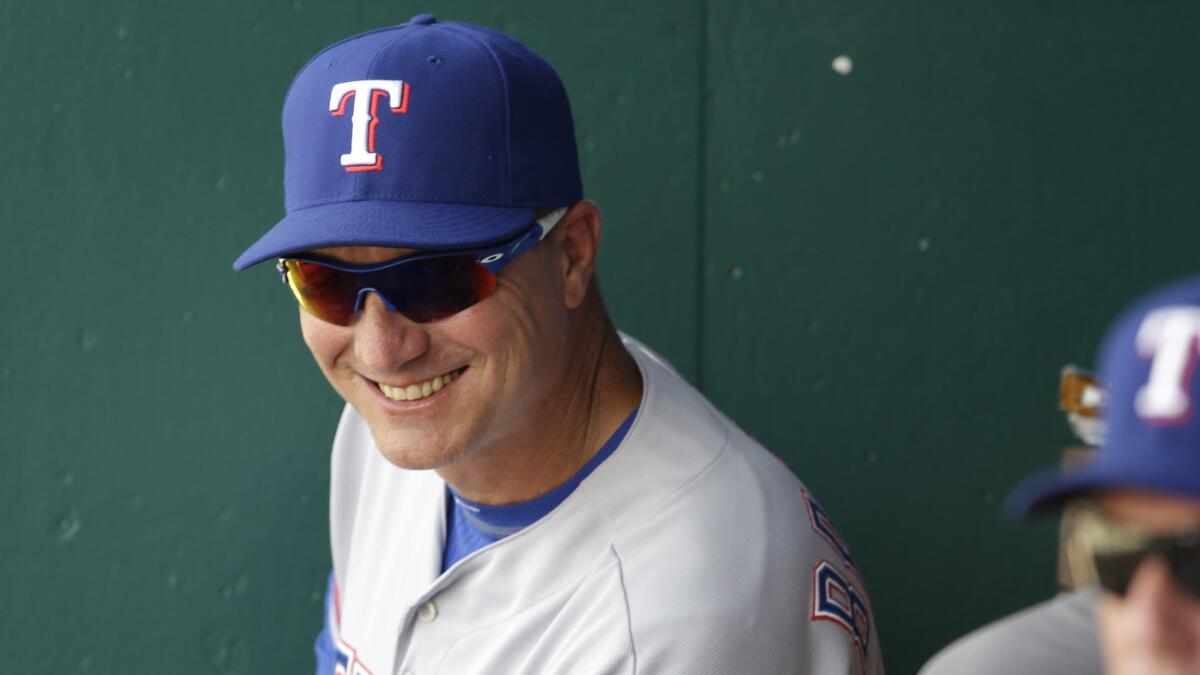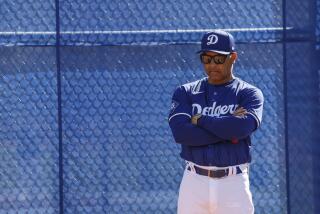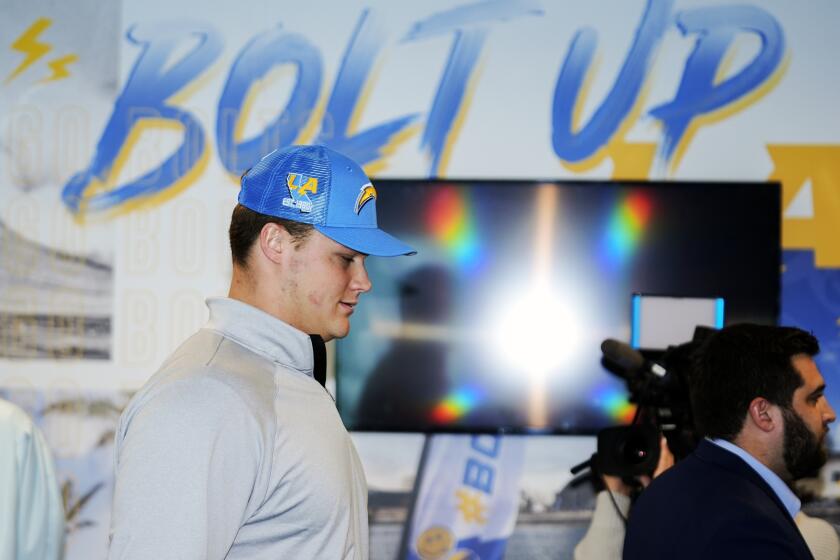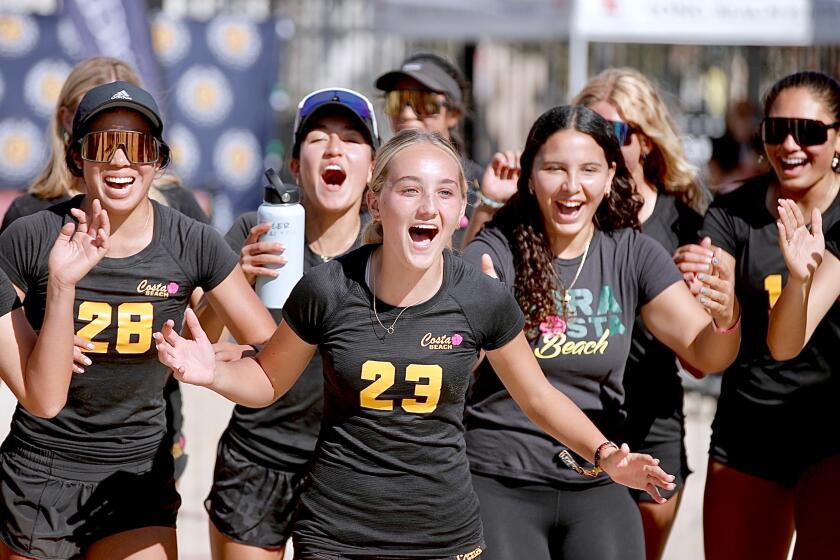Texas Manager Jeff Banister a true baseball lifer: He owes his life to game

Texas Rangers Manager Jeff Banister smiles in the dugout during the eighth inning of a win over the Kansas City Royals on June 6.
During the long days and longer nights in the hospital, when he closed his eyes, Jeff Banister saw diamonds and baseballs.
This June afternoon at Dodger Stadium, with the sun shining over the San Gabriels and the mitts popping, is one of those days he had fantasized about during two long hospital stays in his youth.
Now, though, it is all real.
For the moment, Banister is indoors, in the visiting manager’s office at Dodger Stadium. He hates being inside, but a few hours here is a small price for what he has become, the first-year manager of the surprisingly relevant, refreshingly fun Texas Rangers, 6 1/2 games out of the American League West lead entering the weekend.
As his onetime manager, Jim Leyland, put it, “He’s been doing a hell of a job.”
Banister was hired in October after 29 years in the Pirates organization, during which time he did nearly everything but rip tickets at the box office.
“He had held every position in the minor leagues that there is to offer,” Pirates Manager Clint Hurdle said.
Eventually, he rose to bench coach, where Hurdle groomed him to become a manager. Banister shadowed him everywhere, Hurdle said. He was involved daily with the Pirates’ use of advanced statistics. He was also known to sit alone in the dugout before most games, relishing the view.
With the Rangers, Banister has married a new-school statistical approach with the touch of a baseball lifer. First baseman Prince Fielder says Banister trusts his players — a mix of proven veterans with a gaggle of rookies — to be themselves.
Recently, Fielder face planted while making the turn around third base. Instead of wincing, his teammates fell over laughing. Fielder got up and pointed at the imaginary sniper he claimed took him down. The dugout erupted.
“They search for the joy within the game,” Banister says.
Few know better than Banister of baseball’s joy, and the fissure it leaves when it is wrenched away. As a boy, Banister twice faced death and, nearly as frighteningly for him, the end of baseball.
As a high school junior in Texas, Banister complained about an odd swelling in his right ankle. Doctors found cancer, and cysts led to an infection that ate at the bone marrow. They told him he could die without an amputation.
Banister, young and brash, wasn’t as scared as he ought to have been. The night before surgery was scheduled, he told his father he’d rather die than lose the leg.
As the doctor walked him through the procedure, he felt afraid for the first time. He looked at his parents for strength.
“You’re not going to take my leg,” Banister said to the surgeon. “I need both my legs to play in the big leagues.”
The doctor looked at him.
“We’ll make that decision.”
Now, in the office, Banister leans forward on his desk.
“All I know is I woke up with both of ‘em,” he says. “So I was happy.”
A stream of visitors and friends kept Banister positive, and after he’d recovered fully, his game was still sharp enough to make the team at Lee Junior College in Baytown, Texas. It was sharp enough, in fact, to draw attention from major league scouts.
One night, he received word from his coach that they were in town. He was supposed to have the day off, but the coach told him he’d start behind the plate.
The fifth inning rolled around with a runner on third and less than two out. There was a shallow fly ball to right field, and the outfielder caught it flat-footed. The runner tested him. The throw sailed up the line.
Banister stationed himself in the baseline and anchored himself with his knee, thinking the runner would try to curl around him.
Instead, the runner tried to hop over him. His knee collided with the top of Banister’s head.
“My first instinct was to get up and get the ball,” Banister says. “And I know I leaned up and just went straight back down. I was lying on the field facing the outfield. I know that because I asked questions later. And the reason why I asked questions was because there was a moment that either I was knocked out or somewhere else.”
When he came to, a coach was cradling his head, and blood was streaming down his face. He saw his father standing over him.
“You can’t really feel anything, can you?” he said.
“No,” Banister said, and he asked if the runner was out.
The collision had shattered three vertebrae. In the hospital, his mother cut off his bloody uniform, and doctors put him in traction. After the initial worry that a wrong movement or a sneeze could lead to full paralysis or death, they removed bone from his hip to graft onto his spine. It took three surgeries. After that came the boredom.
It was, Banister said, a dark time. At first he asked questions, but when no answers came, his mind wandered back to long summer days on a diamond. He hated being inside, hated the sterile smell, hated nights especially. So he thought of baseball.
After about a year in the hospital, Banister had lost 85 pounds and still required a walker to get around, but he was ready to go home. His grandfather picked him up, and as he wheeled him to the car, a doctor told Banister: “You need to pick another hobby.”
“Doc, you don’t get it,” Banister said. “I’m playing in the big leagues.”
“If this happens again,” came the reply, “you’re not walking out of this hospital. We’ll be putting you in the ground.”
It was clear that Banister was not yet ready to give up baseball, and soon, he was back at Lee, where he became a junior college All-American. He transferred to the University of Houston and was drafted in the 25th round by the Pirates in 1986.
Apparently, the Pirates did not have much use for a light-hitting, defensive-minded catcher, but in his sixth season in the organization, the big league club needed a temporary backup. Banister was called up.
Leyland, the manager, told him he would get him an at-bat. It was July 23, 1991, and years later, Leyland told a reporter he still gets choked up thinking about the moment.
Proving everyone wrong , Banister had made it to the big leagues. And he got a hit at that.
On first base, Banister was overcome. He felt overwhelmed — by joy, yes, but mostly by responsibility. It is a feeling that has lingered. Sitting in the manager’s office, Banister’s speech slows.
“I hope in the end, that all the people that helped me along the way . . .”
He stops, looks away and fidgets with the day’s lineup card for a long time.
After a moment, he gulps in some air and finishes.
”. . . are proud every day.”
Banister never got another at-bat. Technically, his career batting average in the major leagues is 1.000. And he hopes his one at-bat provided some payoff for those who helped him get there.
The ball never left the infield. He just didn’t allow the shortstop’s throw to beat him.
“Yeah I wouldn’t change it,” he says. “I really wouldn’t.”
He explains. A home run would’ve been nice. But an infield single? That was like a dream.
More to Read
Get our high school sports newsletter
Prep Rally is devoted to the SoCal high school sports experience, bringing you scores, stories and a behind-the-scenes look at what makes prep sports so popular.
You may occasionally receive promotional content from the Los Angeles Times.







